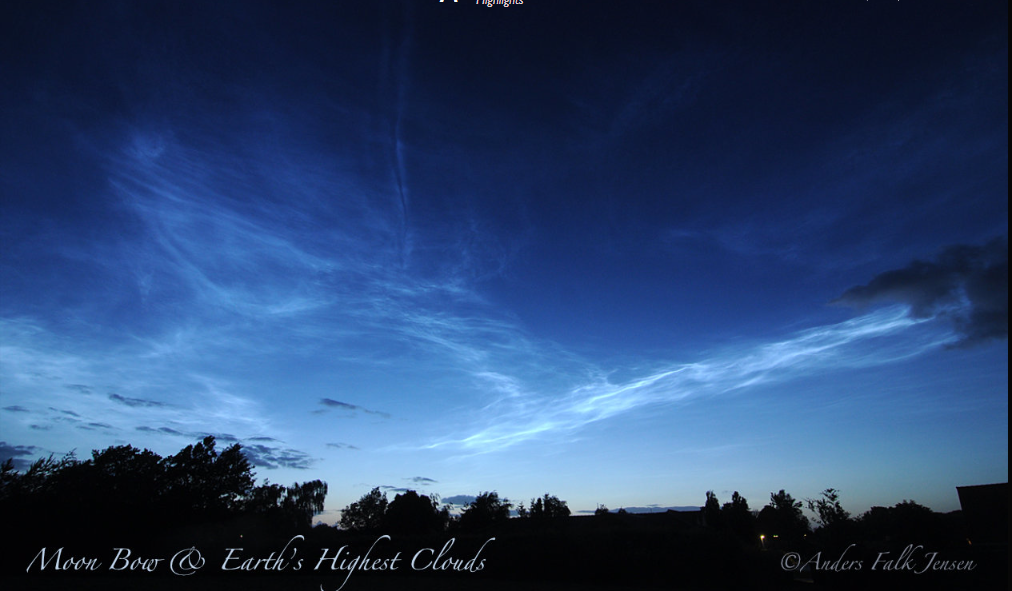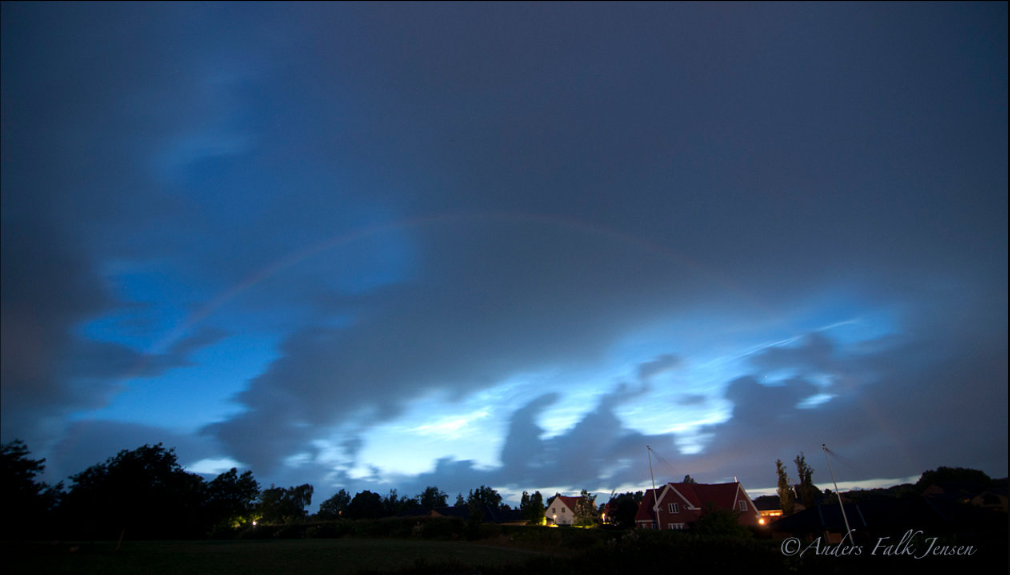Noctilucent clouds NLCs and Moon bow, Denmark
Noctilucent Clouds (NLCs) and Moon Bow in Denmark: A Spectacular Nighttime Phenomenon
Have you ever witnessed a breathtaking display of nature that left you in awe? For one lucky observer in Denmark, the night of July 5th to 6th proved to be an extraordinary experience. Anders Falk Jensen, a keen enthusiast of atmospheric phenomena, found himself captivated by the celestial wonders above. As darkness enveloped the sky, he was greeted by a magnificent spectacle of noctilucent clouds (NLCs) stretching across the entire expanse from south to north. This all-encompassing display set the stage for an unforgettable night.
Noctilucent clouds, often referred to as "night shining" clouds, are a mesmerizing sight to behold. They are Earth's highest clouds, residing in the mesosphere at altitudes of approximately 50-53 miles. These ethereal formations exist at extremely cold temperatures, plummeting as low as -160 degrees Celsius. The unique combination of their altitude and frigid conditions contributes to their striking appearance.
Interestingly, there is a paradoxical relationship between the frequency of NLCs and climate change. As the surface and lower atmosphere of our planet warm, the mesosphere actually cools. This unexpected phenomenon may explain why these enigmatic clouds are becoming more frequent. As we continue to study and understand the intricacies of our changing climate, the behavior of NLCs provides valuable insights into the complex dynamics of Earth's atmosphere.
As Jensen observed the celestial canvas above, he noticed another celestial phenomenon unfolding before his eyes: a moon bow. Moon bows, similar to rainbows, are created when moonlight is refracted and reflected by water droplets in the atmosphere. The precise geometry of a moon bow contrasts with the seemingly chaotic patterns of NLCs. In Jensen's long-exposure photograph, the moon bow remained fixed while the lower tropospheric clouds blurred, allowing the delicate details of both phenomena to be captured in a single frame.
The convergence of NLCs and a moon bow in the Danish night sky created a truly magical experience for Jensen. The interplay between these celestial marvels showcased the intricate beauty of nature's artistry. The ephemeral nature of these phenomena serves as a reminder of the fleeting moments that can leave an indelible mark on our memories.
To fully appreciate the grandeur of this nighttime spectacle, it is crucial to understand the scientific principles that underpin these phenomena. Noctilucent clouds owe their luminosity to their high altitude, where they catch the sun's rays long after sunset. The scattering of sunlight by ice crystals within these clouds gives them their characteristic ethereal glow. Moon bows, on the other hand, result from the interaction between moonlight and water droplets in the atmosphere, following the same principles as rainbows.
Witnessing such rare and captivating displays encourages us to delve deeper into atmospheric optics and explore the wonders that lie above our heads. By studying these phenomena, scientists gain insights into the intricate workings of our atmosphere and the complex interplay between various atmospheric components.
As we continue to unravel the mysteries of the atmosphere, it is essential to cherish and document these extraordinary events. Each observation contributes to our understanding of atmospheric optics and helps us piece together the intricate puzzle of Earth's ever-changing skies.
So, keep your eyes on the sky and be ready to capture those fleeting moments of wonder. Whether it be noctilucent clouds dancing across the night canvas or a moon bow gracing the heavens, nature's celestial spectacle awaits those who dare to look up.


Moon Bow & Earth's Highest Clouds Anders Falk Jensen
Sky scenes from near Silkeborg, Denmark by Anders Falk Jensen.
"The night between July the 5th and 6th proved to be a good one for a friend of the atmosphere. As the darkness grew, I noticed the whole sky was filled with noctilucent clouds, from south to the north. Truly a grand all sky-display. Then I watched the full moon rising between the clouds to the southeast, in conjunction with Jupiter, wow.
Around midnight rain clouds came moving in from the west. The moon was still free from clouds, so I got my camera ready with higher ISO and long exposure. Quite quickly I noticed a weak moon bow on my camera screen, and later I was looking at a complete bow along with the NLC's in the cloud gaps. What a sight, what a night!"

In the topmost picture, noctilucent clouds (NLCs) throw a delicate skein over the sky. They are Earth's highest and coldest at some 50-53 miles up in the mesosphere where temperatures
can be -160 Celsius.
They might be growing more frequent. Paradoxically, as Earth's surface and lower atmosphere warms with climate change the mesosphere cools.
Above: The precise geometry of a moon bow contrasts with the apparent chaos of NLCs. In this shot some are still visible through gaps in the lower scudding tropospheric clouds.
Note how in this 13 second exposure the lower clouds blur but the moon bow stays fixed as do the much higher NLCS.

Note: this article has been automatically converted from the old site and may not appear as intended. You can find the original article here.
Reference Atmospheric Optics
If you use any of the definitions, information, or data presented on Atmospheric Optics, please copy the link or reference below to properly credit us as the reference source. Thank you!
-
<a href="https://atoptics.co.uk/blog/noctilucent-clouds-nlcs-and-moon-bow-denmark/">Noctilucent clouds NLCs and Moon bow, Denmark</a>
-
"Noctilucent clouds NLCs and Moon bow, Denmark". Atmospheric Optics. Accessed on November 26, 2024. https://atoptics.co.uk/blog/noctilucent-clouds-nlcs-and-moon-bow-denmark/.
-
"Noctilucent clouds NLCs and Moon bow, Denmark". Atmospheric Optics, https://atoptics.co.uk/blog/noctilucent-clouds-nlcs-and-moon-bow-denmark/. Accessed 26 November, 2024
-
Noctilucent clouds NLCs and Moon bow, Denmark. Atmospheric Optics. Retrieved from https://atoptics.co.uk/blog/noctilucent-clouds-nlcs-and-moon-bow-denmark/.